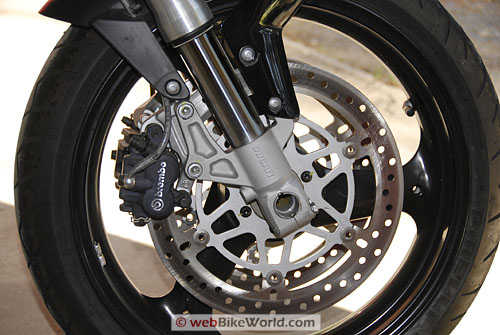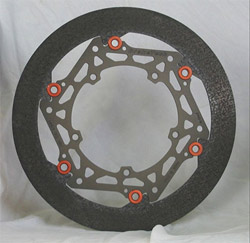About brakesI want to help clear the air here so that everyone who is looking for more information regarding brakes in general and possibly upgrades will have a better understanding of the individual components, what they do and how they interact with one another. I'm only trying to give everyone as accurate information as possible regarding Ducati's OEM brakes for various models, but mostly Monsters.
I'm basing the years on when they first appeared on Monsters, other models got parts at different times. With this info I hope to help others make good decisions with regards to their brakes.
Calipers:There are a few different types of OEM brake components depending on the year and model of bike.
Any mention of "gold line" this this post means specifically that the calipers have 4 pistons which are 30/34mm in size (yes, they are 2 different size pistons in each side of the caliper) and have only 2 pads per caliper.
There were 2 different types of "gold lines" throughout the years. They are generally referred to as "single pin" or "double pin" and those pins are used to hold the brake pads in place. These calipers are designed to work with 320mm rotors.
From 1993 - 1999 Monsters, SS's & 851/888's used "single pin" gold lines that had 40mm spacing between the mounts that held them to the forks. The smaller bikes (600's & 750's) generally only used one caliper on the left side.
There is some mention a few years back from Chris Kelly that the original “single pin” calipers had a little more flex to them then the newer “dual pin” calipers. The pic below is a "single pin" gold line.

From 2000 - 2007 "most" Monsters, SS's and ST's used "dual pin" gold lines which had 65mm spacing between the mounts that held them on the forks. Functionally these are identical to the "single pins". Again some smaller models used only one caliper on the left side.
The pic below is a "dual pin" gold line.

In 2006 to current some Monsters used the black 2 piston calipers which are also used on the Classic series bikes with the spoked wheels. These calipers have only 2 pistons on one side. These calipers are designed to work with 300mm rotors. They still use the same 65mm fork mount calipers as other similar year Ducati's (either the gold line "dual pin" or the 4 pads are the same 65mm).
See pic below for what these look like

In 2007 when the S4RS first came out it used "radial mounted" calipers. Also the 749R/999R had these as well. This refers to how the caliper(s) attach to the fork legs. Basically the bolts which hold the caliper to the fork lowers are perpendicular to the front wheel axle. I don't have the pistons size(s) for these. All of these "radial mounts" use 4 individual pads per caliper.
there's probably a model that doesn't, but most are 4 padsSee pic below for what these look like

or

"4 pads" These calipers were used on some of the 749/999 & 748R/996R/998R bikes and sometimes found their way onto the front of other Ducs. These are the only "axially mounted" calipers which use 4 individual pads per cylinder and they are not "gold lines". They are always called "4 pads" and they come in either silver or gold. They are easily distinguished by the bridge that goes over the top center of them connecting each side of the caliper. Note: people often confuse these with "gold lines" or vice versa. They are very different calipers. These have 34/34mm pistons and more initial bite to them. Because of the larger leading piston and twice as many leading brake pad edges as a "gold line".
See pic below for a "4 pad"
 Master Cylinders
Master CylindersAgain there are a few different types that Ducati has used over the past 15 years.
1993 - current There have been both coffin style and gold line aka "pee cups" or "remote resivours". For the most part they are BOTH 16mm pistons as long as it's for dual calipers. There were a few 15mm's but I highly doubt you're going to trip over them these days.
I'm not sure what the 300mm 2 pistons use, but I'm betting it's either 15 or 16 and most likely 16mm. The only difference between the pee cups and the coffins is look and clearance to the surrounding area. They also use different levers which are not interchangeable. <-- One exception here, the first generation of remote style's used the same large bolt for the lever and you could swap levers between coffins and remotes. But those stopped being produced about 1997/8 when they went to the now used smaller bolt on the remotes. The coffins always have/had the larger bolt holding the lever to the master and since 1998/1999 the remotes have had the smaller bolt.
For the single caliper front brakes
(I believe) Ducati used either a 13mm piston as it was only pushing half as many brake pads.
If you plan to switch either way, keep this in mind as it will drastically effect the feel/power of your most valuable brake. Pics of each below
Coffin

Remote

Ducati also uses Radial master cylinders on the latest Monster S4RS and S4R-2008. The advantage to radial master cylinders is improved power/feel.
But in all honesty you don't get much of either with these. Don't get me wrong they're still great brakes! But if you want more spend the extra $$ and get the racing radials from Brembo for the best of both power and feel.
Pic below of what's on the S4RS

The 749/999's also use radial masters. They have 18mm pistons and a banjo bleeder inside the resivours which can be handy for getting the last little bit of air out of the system.
 Rotors
RotorsThere are 2 types of rotors that Ducati has used in most models.
They are "semi floating" and "full floating". Please realize, "semi floating" is closer to fixed than full floating.
What this is referring to is the way the actual brake rotor blade (the outer most part where the pads grab) stays fixed or "floats" where it's connected to the rotor's carrier/center by the buttons.
Like everything else on a bike, the main goal here is to have incredible performance that doesn't weigh very much and maybe even last a while.
This weight is especially noticeable because it's added to that gyroscope we call the front wheel.
The main reasons for different materials for the blade and the carrier and the different ways of attaching these 2 components together is because they get VERY hot and can warp. Also because if the rotor is "floating" it can move with very little or no resistance by the brake pads as they usually pretty close to one another.
Semi floating rotors are far more common these days and also less expensive to produce.
The most common material for the blade is
stainless steel. It allows use of wider variety of brake pads, it doesn't rust very easily and is less expensive to produce. Other materials used for the blades are "Iron", "Carbon" and "Carbon Matrix Composites aka CMC's".
Iron blades have been used in racing for years as they provide excellent power/feel. The only drawbacks are that it's slightly heavier and have a limited amount of brake pad choices (organic only).
Carbon blades are very light and ONLY used in racing, because they do not work well until they have built up heat in them. But when they're hot, they're incredibly powerfull! Not to mention they take many months to produce and are VERY expensive and have limted choices in terms of brake pads.
Carbon Matrix Composite rotors have only been developed in the past few years. They have the lightness and power of Carbon rotors, but they have been developed so that they work well all the time. They are also very light and take far less time to produce.
The image below shows Cookie cutter rotors common on all Monsters from 1993-1999. They had steel carriers and stainless "semi floating" rotors.

The image below shows "Snow flake" rotors common on most Monsters from 2000 - 2006. They had aluminum carriers and stainless "semi floating" rotors.

The image below is "Full Floating" rotors which were only on the 2000 S model Monster as well as a few other Ducati's

The image below is a "Full Floating" CMC rotor.

Important size/notes about the rotors. They are mostly all 320mm in diameter and have 6 bolts holding them to the front wheel. The only exceptions are the newer Monsters that have the 2 pad calipers as they have 300mm rotors, but the same 6 bolt pattern to the front hub. Also the S4RS and 2008 S4R have a 5 bolt pattern holding a 320mm rotor to the front hub.
All SS's and ST's have 320mm with 6 bolt. All 749/999 have 320's with 5 bolts holding to front hub and a different offset. The only odd balls in this are some of the 748R/996R/998R and 749R/999R as they have a different offset, have 6 mounting bolts and require special 320mm discs.
Brake PadsThis is the cheapest and easiest way to improve the performance of your bikes brakes. There are many choices here and I"m not going into each one. I will only say that you need to listen to what others have to say and test/try yourself. Good brake pads combined with a freshly changed good brake fluid and stainless brake lines can do wonders to improve the performance of your brakes. Most high performance brake pads are "sintered" which means they have metal bits in them to increase the stopping power.
Brake linesStock brake lines on some bikes are often rubber, this deteriorates over time and also expands under hard use. Both of which are not good for either feel or performance. Best solution is to use stainless lines as they don't deteriorate and they don't expand. Just make sure the stainless lines have a coating over them
(most do these days) or they work like saws on anything they rub against. Thankfully for us, Ducati uses stainless lines on most all models for the past 10 years at least. So we've got brake lines covered from the factory

A few last words here
Keep in mind the old Pirelli add
"Power is nothing without control" when considering what you want your brakes to do.
Also ask your self "how do you want them to feel, either hard or soft and should they grab the same all the time or get progressibly stronger?
The choice is yours and you can combine many things to achieve what ever you want.
A few good links:
http://www.oppracing.com/pages/articles_brembo_master_cylinders/http://www.braketech.com/tech_talk.phphttp://www.yoyodyneti.com/Product/brembo_brakes.htmhttp://www.ducatitech.com/2v/aftermarket/brakes.html



